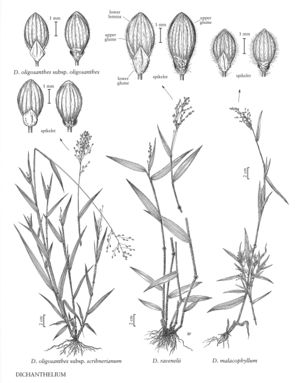Dichanthelium oligosanthes subsp. scribnerianum
Culms 20-50 cm; internodes often lustrous, glabrous or sparsely papillose-hispid (rarely puberulent). Cauline sheaths often lustrous, glabrous or sparsely papillose-hispid (rarely puberulent); ligules 1-1.5 mm; blades usually 6-15 mm wide, less than 10 times longer than wide, flat, ascending to spreading, glabrous or sparsely pubescent abaxially, acute. Primary panicles denser than in subsp. oligosanthes, branches more flexible; pedicels mostly shorter than 5 mm. Spikelets usually 2.7-3.5 mm long, 2-2.4 mm wide, broadly obovoid-ellipsoid, usually glabrous. Upper glumes with a prominent orange to purplish spot at the base.
Discussion
Dichanthelium oligosanthes subsp. scribnerianum grows in sandy or clayey banks and prairies. Its range extends from southern British Columbia to the east coast of the United States, and south into northern Mexico. It is the most widespread of the two varieties.
Selected References
None.
